Sterling Silver PMC
What’s the deal with Sterling Silver clay? The upside
There was a time, granted it was a few years ago, where it was considered impossible to have a commercially available Sterling Silver Clay. Since 2012 Mitsubishi – the manufacturers of Precious Metal Clay (PMC) created and brought to market a Sterling Silver clay that can be used just like its Fine Silver counterpart.
I thought I would write this blog in 2 parts, exploring the good and the not so good points about Sterling. Then you can make up your own mind about it and whether it’s something you’d like to try.
So what’s so great about Sterling Silver Clay?
Price and value for money
This is possibly one of the main advantages of Sterling silver PMC; because Sterling is a silver alloy (i.e. it is a mix of silver and copper) it is a little cheaper than fine silver gram for gram. And because it’s a silver alloy you can roll it out thinner; a little goes a longer way. This is because the copper content makes the clay more durable and stronger than fine silver, so you can use less clay than you might otherwise do with fine silver.
When it’s in the greenware state (i.e. dry but not fired) it is stronger than fine silver too and more flexible. So there’s not the awed hush and holding of breath if you sanding a particularly delicate piece – although please don’t go hell for leather, it is still clay after all ;o)
Perfect for ring bands
If you like the flexibility and the ease of texturing PMC but have always worried about the tensile strength of it when making ring bands, then this is definitely an answer. Just be aware that you need to make allowances for a larger shrinkage than PMC3. Where PMC3 shrinks about 12 – 15%, Sterling has a larger shrink rate, typically between 15 – 20%. This means that you will have to make the clay band bigger to allow for more shrinkage. For ring making, I generally teach my students in American ring sizes because I use ring pellets to control shrinkage and you only find them in US sizes. So I allow 3 US ring sizes for shrinkage. For example if I wanted a size 8 ring, I would make a ring initially a size 11, but a word of warning, don’t use investment ring pellets for Sterling rings – it can mark the inside and this is extremely difficult to remove without using abrasion. If you want more information about this, have a look at Janet Alexander’s blog.
Texturing, carving and engraving
Like all versions of PMC, the Sterling takes texture very well. It also carves and engraves beautifully – everyone including me seems to agree with this point. Because Sterling PMC is a little bit more flexible and strong, it withstands a little more pressure when carving.
People know what Sterling is!
The uninformed jewellery buyer out there is not sure of the difference between Sterling and fine, they are not truly interested since they only care what the piece looks like and if it is ‘silver’. But Sterling is a universally known type of silver that needs no explanation.
Tomorrow we’ll look into the things you will have to think about! But if you have any questions, let me know below.
Til next time
Emma x







0 Comments